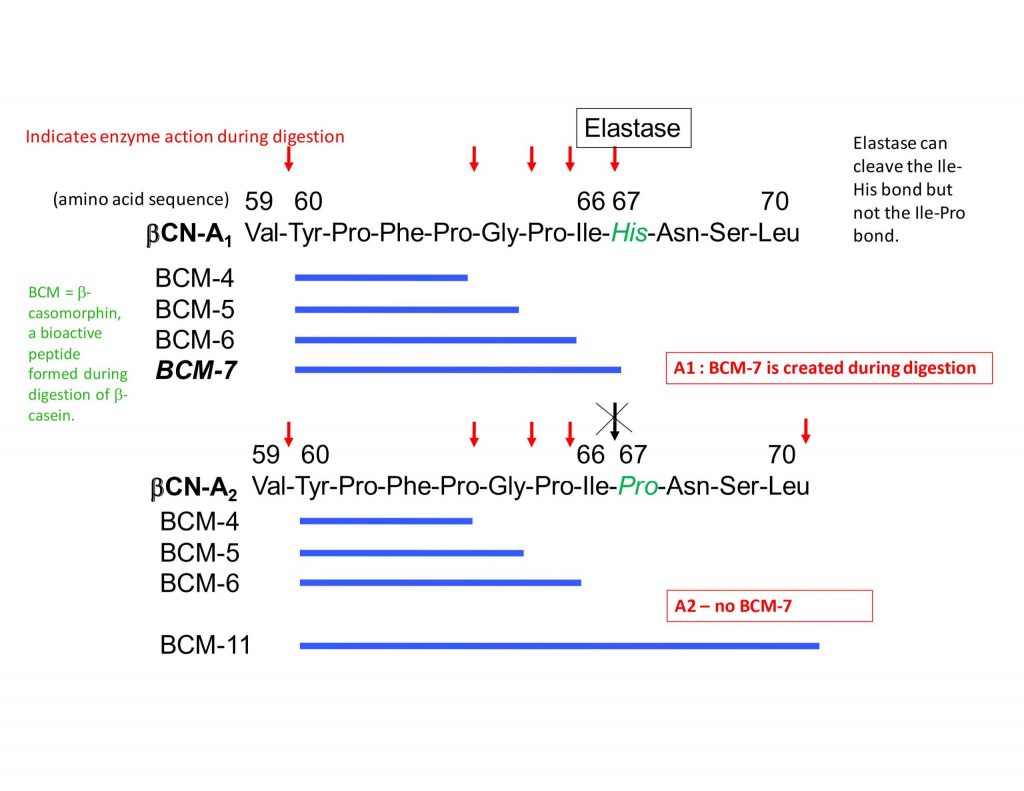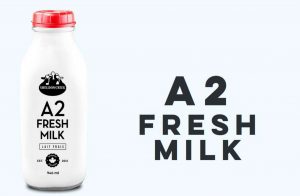Milk Protein Phenotypes
Understanding Genotypes and Phenotypes
In 1995, Aschaffenburg and Drewry (1955) observed that when milk samples from individual cows were subjected to electrophoresis certain specific conditions, their samples produced either one of two or a mixture of both electrophoretically distinct
β-lactoglobulin bands which were denoted as β1– and β2-lactoglobulin in order of decreasing mobility. This nomenclature was later replaced by A and B, respectively, when it was discovered that the synthesis of these two types of β-lactoglobulin was under genetic control. That meant that for the first time, the possibility of phenotyping animals prior to lactation, at birth for example, could be used to the farmer advantage.
But before we enter into this topic on more details it is important to be clear about certain definitions:
- According to the National Human Genome Reserach institute a genotype is “an individual’s collection of genes. The term also can refer to the two alleles inherited for a particular gene. The genotype is expressed when the information encoded in the genes’ DNA is used to make protein and RNA molecules. The expression of the genotype contributes to the individual’s observable traits, called the phenotype”
- Christopher P. Austin, M.D. from the same institute defines phenotype as; “Phenotype” simply refers to an observable trait. “Pheno” simply means “observe” and comes from the same root as the word “phenomenon”. And so it’s an observable type of an organism, and it can refer to anything from a common trait, such as height or hair color, to presence or absence of a disease. Frequently, phenotypes are related and used–the term is used–to relate a difference in DNA sequence among individuals with a difference in trait, be it height or hair color, or disease, or what have you. But it’s important to remember that phenotypes are equally, or even sometimes more greatly influenced by environmental effects than genetic effects. So a phenotype can be directly related to a genotype, but not necessarily”. The illustration below shows how a genotype results in phenotypes. But as mentioned, phenotypes are also influenced by the environment.

Figure 1. Genotypes produce phenotypes.
In milk proteins, The different phenotypes are identified as changes in the amino acid sequence of different genetic variants and are the result of nucleotide sequence changes in the codon which could be detected by several molecular genetic techniques. In addition to alleles in the milk protein genes which result in genetic polymorphism of milk proteins, several other alleles in the non-coding regions of the genes have been identified.So the changes in the should not be confused with the changes in the milk proteins (different phenotypes)
Most of the work on the genetic polymorphism of milk proteins has been performed on cattle. The different genetic variants of the major milk proteins so far identified are represented schematically in Figure 2. Please note that these variants are identified by one particular method while other methods can identify other variants, for example, κ-casein F, G, H, I, J can be differentiated by isoelectric focusing.
Caseins
- αs1-Casein: A B C D E F G
- αs2-Casein: A B C D
- β-Casein: A1 A2 A3 B C D E F G
- κ-Casein: A B C E
Whey Proteins
- β-Lactoglobulin: A B C D E F G
- α-Lactoalbumin: A B C
Figure 2. Different phenotypes of milk proteins (Adapted from K.F. NG-KWAI-HANG AND F. GROSCLAUDE )
Genetic polymorphism in the milk proteins happens by substitutions or deletion of certain amino acid sequence along the peptide chain as a consequence of mutations causing changes in the sequence of base pairs of the DNA molecule which constitute the protein gene. Is important to differentiate between polymorphism which is due to a mutation resulting in a change in the amino acid sequence of the protein and polymorphism due to post-transcriptional modification such as different degrees of phosphorylation and/or glycosylation of the protein.
Relations have been observed between genetic polymorphism of milk protein and milk content of fat and protein, and to a lesser extent of minerals and other organic ions. This relationships might
have a considerable effect on milk production, milk health effects and the manufacturing properties of the milk. Differences in amino acid composition and sequence for genetic variants could partially explain changes in the properties of the molecules through a combination of a series of modification including net charge, hydrophobicity, degree of phosphorylation and glycosylation, all of which contribute to the behaviour of milk proteins and hence the overall manufacturing properties of the milk. However, we need to keep clear that the associations between different phenotypes and processing parameters are correlational and not consequencial.
The concepts of genetic polymorphism the peptide chain and properties of milk can be illustrated by studying the two “famous” A1 and A2 variants of β-caseins.
 Figure 3. Peptide sequence of β-Caseins A1 and A2 with indications of digestive enzyme activity sites and the bioactive peptides produced during digestion. By Doug Goff.
Figure 3. Peptide sequence of β-Caseins A1 and A2 with indications of digestive enzyme activity sites and the bioactive peptides produced during digestion. By Doug Goff.
The basic variation between the phenotypes A1 and A2 of β-Casein is one amino acid at the 67 position. The significance of that has been observed in the digestion of b-casein, as shown on figure 3. Te digestive enzyme elastase is able to break down this portion of the β-Casein creating several peptides which have some health related effects. Lots have been said about the benefits of milk containing the A2 variants, but not enough research have been published. Regardless of all what have been said or published, the fact now seems to be that some people for whom milk causes discomfort during digestion, similar to lactose intolerance (more on that later), find that they can drink and tolerate well the A2 milk.
You can get “A2” milk by doing a genetic test on the cows to see which variant of b-casein they synthesize, then segregating all the A2 cows and collecting their milk. Over time, you can breed for A2 cows and increase the numbers in your herd. Currently in Canada, it is about 50/50, but if the A2 milk isn’t isolated, then we do have A1 b-CN in the milk, and we do form some BCM-7 during digestion. A2 milk has already been commercialized.

Effects of different phenotypes have been reported on the amount of protein fraction in milk, the casein to total protein ratio, casein micelle stability, coagulation and emulsification properties, etc. These differences on the coagulation properties are also reflected in cheese yield and cheese composition which is a determinant of cheese quality.
The influence of genetic polymorphism on the composition and properties of milk from species other than bovine, especially caprine and ovine, have also been studied extensively.
Electrophoresis is a laboratory technique used to separate DNA, RNA, or protein molecules based on their size and electrical charge
